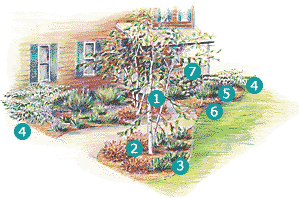 Basic Entry Garden Plan
Basic Entry Garden Plan
This design provides the structure an entry garden needs. Use it as is, or adapt it to your home and region as necessary. The plants are widely available; their recommended USDA Hardiness Zones are in parentheses.
Whether you're updating an existing entry garden or starting from scratch, a few key principles can help you create a garden with a fresh, professional appearance. Here I explain how to begin, and suggest basic concepts that will help you design plantings with depth and four-season interest.
Start by making a list of the garden's required and desired features. Basic guidebooks, such as Landscaping For Dummies, (Hungry Minds Inc., 1999; $17), provide many ideas and sample plans. Your garden center is another good place to start. Ask them for advice. Also check with local master gardeners and your cooperative extension office.
Once you know the features you want and the specific tasks to accomplish, note which jobs you will do yourself and those for which you'll want to hire a professional. Often, the success of a do-it-yourself home landscape hinges on knowing when and where to get help.
Layers and Curves
Many houses suffer from being surrounded by a single row of plants placed close to the foundation. The most dramatic way to update such a design is to widen the planting area and plant in layers. That means situating the tallest shrubs near the house, medium-sized shrubs in the middle, and lower-growing ground covers and perennials in the front and nearest to the borders of beds. If you have space, include a small tree or large shrub to serve as a focal point. Underplant trees with perennials, ground covers, or low shrubs.
Unless your house is designed to suit geometric planting beds (such as a Federal-style brick townhouse or a wood-and-glass California contemporary), think in terms of curves. Serpentine planting beds and walkways counteract the geometric planes of a house and appear more natural. Choose a place for a bench or a tree with plantings around it to provide anchoring elements.
The main entry path to the house should be easy to find and navigate; consider safety and maneuverability as well as good looks. If your path is not already in place, consider curving it, too.
Color and Texture
Professional designers try to plan for appeal in all four seasons. While spring and summer flowers and fall color dazzle, it is more difficult to create interest when the flowers fade or the leaves drop. For that reason, include plants with flowering seasons other than spring, with colorful or variegated foliage or distinctive fruit, and trees and shrubs with unusual bark or branch structure. The spent flowers or drying seedpods of some plants are intriguing, and many hardy evergreens (such as junipers and rhododendrons) change from green to plum or russet colors in fall and winter.
Changing textures add pizzazz to the design, as do curving lines and repeated plants. An easy way to include different textures is to mix evergreen and deciduous plants. Introduce texture by mixing spiky and daisylike flowers; small round leaves and long grasslike leaves; and woody shrubs with soft-stemmed perennials.
Another design trick is to group plants, usually in odd numbers, and repeat those groupings throughout the beds. This way, your eye is drawn across the entire planting, tying it together and making it look full. For instance, in the garden shown here, both deciduous shrubs and evergreens are repeated on both sides of the walkway, and identical shrubs anchor the corners.
Practicalities
As you get started, be mindful of your soil conditions, the direction your house faces, and patterns of water drainage. Make a scale drawing of your space and how you'd like to divide it. Before sketching any plants in the drawing, consider their mature size. This way, you won't be tempted to choose plants that will be too large or too small for the space available. Then select an appropriate mixture of plants. Consult nurseries and cooperative extension offices, as well as local planting guides.
If available, choose named varieties of plants over species; they are often superior in appearance and performance to unnamed forms of the same plant. Also look for compact or dwarf varieties. Even the most diminutive plant in its nursery container can become a maintenance headache if it is naturally too big for its space. Generally, with the exception of trees, look for plants that grow no higher than your windows.
If you are planting under eaves, remember that plants there will receive much less rainwater and possibly light, depending on the depth of the overhang, than plants exposed to the sky. Supplemental irrigation may be needed.
Jane von Trapp is an author and landscape designer based in New York City.
Illustration by Janet Fredericks